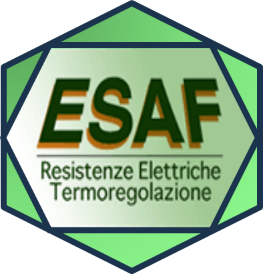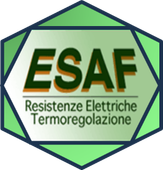Thermocouple Production
Thermocouples are resistance temperature sensors used to measure extreme temperatures, finding application in many sectors.
These sensors have small dimensions and very fast measurement times, and thanks to their high resistance it is possible to use thermocouples even in critical conditions.
The temperatures measured can reach up to 2500°C and, thanks to their extreme resistance and small size, they are among the most common electrical resistors for thermoregulation.
ESAF Srl manufactures thermocouples and cables. You'll find a selection of the best electrical components, offering high performance regardless of their application, all at competitive prices. Resistors for sale.
WHAT ARE THERMOCOUPLES?
They are transducers, temperature meters that base their operation on the thermoelectric effect.
The main advantages are their small size, rapid measurement times and the possibility of being used even at extreme temperatures (depending on the type of thermocouple, up to 2500 C°).
HOW IT WORKS
Thermocouples consist of two conductive wires that, when joined, create a circuit. The thermocouple circuit is composed of two wires made of different metals. The point where the two wires meet is called the hot junction, and it will be in contact with the temperature being measured. The point where the two wires are free (not joined) is the cold junction, and it is in contact with a body whose temperature is already known.
There is therefore a temperature difference between the two junctions that generates an electric current within the circuit. This is the Seebeck effect and is the basis of how thermocouples work. The current generated by the circuit therefore corresponds to a temperature difference between the two junctions. By measuring the voltage present in the circuit, the thermocouple is able to determine the temperature to which the hot junction is exposed.
THE SEEBACK EFFECT
The Seeback effect describes how two metals at different temperatures, when joined together, generate a specific electromotive force. Much will depend on the type of metals used within the thermocouple, allowing for more precise measurements or at specific temperatures. For this reason, thermocouples are classified based on the pair of metals used.
TYPES AND COLOR CHART
The thermocouple manufacturing process allows these metals to be classified based on the types of metals used to make them. The maximum operating temperature varies depending on the metals used, resulting in different application contexts and characteristics.
TYPE K
K thermocouples are made of nickel-based wires and are the most widely used in manufacturing and industrial applications due to their reliability and affordability. Measurement range: -200/ 1370° Celsius.
Thermocouple K Color: Green
TYPE J
Type J thermocouples have a more limited measurement range than K thermocouples. The two poles are made of iron (positive pole) and a nickel-copper alloy (negative pole). Measurement range: -40/ 750° Celsius
J Thermocouple Color: Black
TYPE N
Type N batteries are suitable for high temperatures, similar to type K batteries but more stable and less sensitive to oxidation and extreme external temperatures. Temperature range: -270/ 1300° Celsius
Thermocouple Color N: Pink
TYPE W3
Ideal for very high temperatures, the W3 can measure up to 2500° Celsius. They cannot be used in oxidizing atmospheres or in contact with air. They are the most technologically advanced, used primarily in sectors requiring very high temperatures. Temperature range 0/ 2500° Celsius
W3 thermocouple color: Green
TRADITIONAL OR MINERAL INSULATION?
- The type of insulation used to produce thermocouples defines various performance factors, particularly the speed of response and measurement. There are several types, including: Traditional insulation uses ceramic insulators and protective sheaths made of metal or ceramic. Mineral insulation uses magnesium oxide (MgO) to insulate the metal wires thanks to a highly insulating sheath.
- With mineral insulated cables they have a better response speed and better resistance to pressure and vibration than standard thermocouples with traditional insulation.
USES OF THERMOCOUPLES
The use of thermocouples as temperature sensors is widespread, in both industrial and domestic contexts and applications.
THERMOCOUPLES FOR BOILERS, OVENS AND COOKTOPS
In the home, thermocouples are widely used for heating and operating hobs and ovens.
In these contexts, the thermocouple functions as a temperature regulator thermometer, sending an electrical impulse that controls whether or not the gas valve is opened.
The thermocouple functions here as a safety device for gas ovens and cooktops, indicating the gas valve should close if the flame goes out. Thus, once the thermocouple has measured the temperature drop due to the flame's absence, it will trigger an electrical impulse to interrupt the gas flow.
INDUSTRIAL THERMOCOUPLE PROBES
For measuring high temperatures or under harsh conditions, thermocouples are a fundamental tool in industrial probes used in manufacturing processes. The great advantage of thermocouples is their durability, which allows them to be used in a wide variety of industrial contexts.
THERMOCOUPLES OR RESISTANCE THERMOMETERS: THE DIFFERENCES
Thermocouples and resistance thermometers are among the most widely used temperature measurement probes, both in industrial and residential applications. When choosing which of these electrical components to use, it's crucial to consider two factors: accuracy and the type of temperatures being measured. Thermocouples are less precise than resistance thermometers, but they are easier to calibrate and more durable. If the measurement requires very high temperatures, above 650°C, thermocouples are the ideal measuring instrument, thanks to their wider measurement range.








